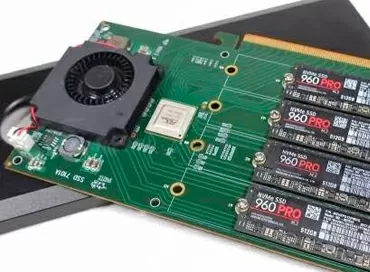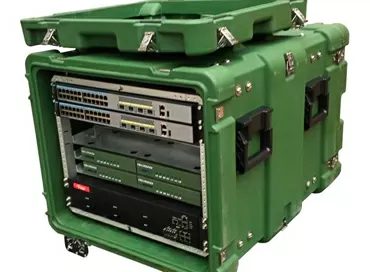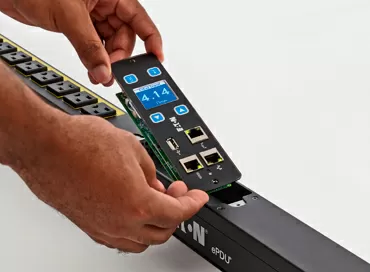HP BladeSystem c-class ultra-dense servers
When designing a modern data processing center (DPC), you can often face the problem of limited space, and, as a consequence, the need to use ultra-high density computing systems. But, as the number of servers grows, the complexity of deploying systems, monitoring them and managing a large fleet of equipment inevitably grows. Also, it should be noted, and the increasing complexity of the infrastructure, which is expressed in the complication of SCS (structured cable networks) data centers and power supply systems. It is for such problems that Blade servers are used. Currently, one of the best systems is the ultra-dense HP BladeSystem c-Class servers.
The HP BladeSystem c-class architecture was developed from the outset without reference to the constructs and form factors of the previous generation of HP BladeSystem (p-class) server blades that have existed for many years, which allowed to implement new ideas and new technologies for data centers in it.
With regard to HP BladeSystem c-class, HP has developed and offers proprietary technologies to users to solve problems related to increasing the flexibility and manageability of the server infrastructure, lowering power consumption and heat dissipation, and reducing the cost of purchasing and owning IT infrastructure:
-
Virtual Connect virtualizes server blade I/O adapters, allowing you to replace, add, and redeploy servers without affecting the SAN and LAN domains that interact with the server infrastructure.
-
HP Thermal Logic technology to reduce overall power consumption and heat dissipation is based on the use of power management capabilities of processors, intelligent cooling systems and component blowing in the server shelf.
-
An updated suite of monitoring and intelligent management tools for HP Blades is now more integrated and functional and renamed HP Insight Control.
-
A unique set of server, communications, and add-on modules that allow you to implement data center configurations to meet a wide variety of requirements.
-
Cost savings at the infrastructure acquisition stage are achieved through the design of the C-class blade system, both for servers and, especially, in terms of the cost of connections to external networks (LAN and SAN).
Actually, in each of its new line of rack servers, Hewlett Packard is trying to reduce heat generation, power consumption and, accordingly, the cost of ownership. The hp proliant dl380, proliant dl360, and proliant dl580 series can boast of these achievements.
The HP c-class blade systems are based on the c7000 and c3000 shelves, which have built-in power and cooling infrastructure and contain slots for server and switching modules.
32 dual-processor or 8 four-processor servers with x86 processors or 8 dual-processor servers with Intel Itanium2 processors, plus 8 switching modules: SAN switches, Gigabit Ethernet, Infiniband, can be installed in a c7000 shelf in a 10U chassis. The c7000 shelf is designed to fit into a standard rack and integrate with other data center components such as other blade shelves.
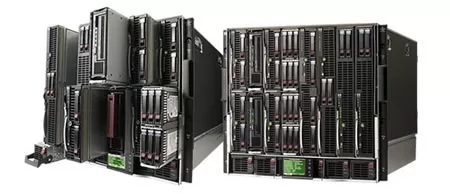
Shelf с7000
The c3000 shelf has a height of 6U and is designed to accommodate half the number of server and switching modules. The shelf can be rack-mountable or supplied as a pedestal kit.
It is important to note that the density of the layout does not at all affect the characteristics of the servers: even the most compact server is equipped with two most modern processors from Intel or AMD, and it can be expanded to 32 GB of RAM. In addition to the BL260 and BL220x2 models, the server is also equipped with 2 hot-swappable SAS disks, and supports up to 6 external interfaces for connecting to integrated switching modules.

Shelf c3000
A range of server models are available for use within the HP BladeSystem c-class infrastructure, based on dual-core Intel Xeon 5000 and 5100 series processors, AMD Opteron 2000 and 8000 series, Intel Xeon 7300 series quad-core processors and dual-core Intel Itanium 2 9000 series processors. All servers use the latest server technologies, such as updated RAM subsystem, new SAS SFF hard drives, new ILO2 remote control processor, multifunctional network adapters with hardware support for iSCSI, TOE, RDMA.
In addition to the actual servers, storage blades, tape blades and expansion blades can be installed in the slots for server modules in c-class systems. They are designed to expand the amount of dedicated disk or tape space directly accessible to the nearest server (storage blades and tape blades) or create additional PCI-X or PCI slots for the nearest server blade.
The listed server and add-on modules can be combined in a shelf in any combination. As part of the HP BladeSystem c-class form factor, it is planned to introduce new products, both servers based on new processors and system architectures, and specialized storage blades that allow creating a shared storage system within the blade infrastructure.
To ensure the integration of HP BladeSystem into the infrastructure of the data center and ensure the interaction of servers with each other, switching modules are used.
Both patch panels that output signals from server adapters in a 1-to-1 ratio and intelligent switching devices & mdash; can act as switching modules. Gigabit Ethernet switches from Cisco or Nortel, Fiber Channel 4 Gbps from Brocade, Infiniband 4x DDR, and I/O virtualization modules - Virtual Connect GigE and FC.
The following types of I/O adapters are currently available for HP BladeSystem c-class servers:
-
2-port and 4-port and Gigabit Ethernet adapters;
-
2-port Gigabit Ethernet adapter with hardware support for TOE, iSCSI, RDMA;
-
2-port 10-Gigabit Ethernet adapter;
-
2-port Fiber Channel 4Gbps adapter (Emulex or Qlogic);
-
1-port and 2-port Infiniband 4x DDR adapters.
Using the HP BladeSystem Infrastructure implies a high level of component redundancy by default. For example, the power of the blade system is reserved according to the 3 + 3 scheme, redundant cooling fans are used, all switching modules are installed in pairs, all used server I/O adapters are at least two-port. As a result, the blade system is characterized by a higher level of server and application availability, usually at a more affordable price compared to similar solutions for low-cost servers.
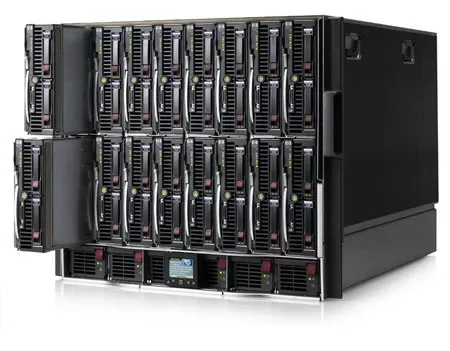
To effectively manage the HP BladeSystem, both shelves include tools to visualize the server shelves and get a clear view of the health and configuration of the blade system, monitor environmental parameters, and configure the cooling and power subsystems.
It is recommended to use the integrated HP Insight Control software package, which includes Systems Insight Manager, and additional management tools: Rapid Deployment Pack, Vulnerability and Patch Management to manage the blade infrastructure throughout the lifecycle Pack, Performance Management Pack.
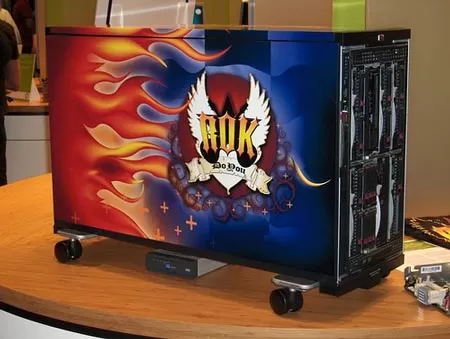
The Rapid Deployment Pack Management Software, in addition to the standard functionality described in the HP Proliant Essentials Software section, includes specific features for working with HP BladeSystem Infrastructure:
-
identification of server shelves and slots in them;
-
the ability to set policies that determine the set of software for the server installed in a given slot;
-
the ability to automatically install a set of software in accordance with a specified policy (when replacing a server in a shelf, at a certain point in time).
Insight Control, integrating Rapid Deployment Pack with server infrastructure monitoring systems, automates recovery processes in the event of hardware and software failures by transferring the functions of the failed server to the server from the spare pool, thus ensuring higher level of application availability.
Conclusions
We can say that Blade systems from HP provide a complete solution, consisting of both a wide range of equipment directly and systems for its control and management. Blade servers support all current protocols and integrate seamlessly into existing environments. This combination of qualities forms the basis of a flexible, reliable and high-quality platform for solving a wide range of tasks.
The table below shows the technical characteristics of the server modules.
|
BL260c |
BL2x220c |
BL460c |
BL460c G5 |
BL465c |
|
Intel Xeon 5400 and 5200, Core ™ 2 Duo or Celeron series |
Intel Xeon 5400 and 5200 Series |
Intel Xeon 5400, 5300, 5200, and 5100 series |
Intel Xeon 5400 series |
AMD Opteron 2300 Series |
|
Quad, Dual or Single |
Quad or Dual |
Quad or Dual |
Quad |
Quad |
|
2 |
2 per Server Node |
2 |
2 |
2 |
|
PC2- 5300 DDR2 Regist ered DIMMs |
PC2-5300 DDR2 Regist ered DIMMs |
PC2-5300 DDR2 Fully Buf fered DIMMs |
PC2-5300 DDR2 Fully Buf fered DIMMs |
PC2-5300 DDR2 Regist ered DIMMs |
|
48GB |
32GB (4 x 8GB) |
64GB |
32GB |
64GB |
|
BL480c |
BL495c |
BL680c |
BL685c |
|
Intel Xeon 5400, 5300, and 5200 series |
AMD OpteronTM 2300 Series |
Intel Xeon 7300 and 7200 series |
AMD Opteron 8300 Series |
|
Quad or Dual |
Quad |
Up to 6 cores |
Quad |
|
2 |
2 |
4 |
4 |
|
PC2-5300 DDR2 Fully Buffered DIMMs |
PC2-5300 DDR2 Regist ered DIMMs |
PC2-5300 DDR2 Fully Buffered DIMMs |
PC2-5300 DDR2 Regist ered DIMMs |
|
64GB |
128GB |
128GB |
128GB |
Dmitry Nechaev
10/03.2009









